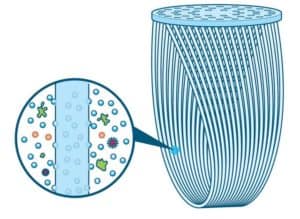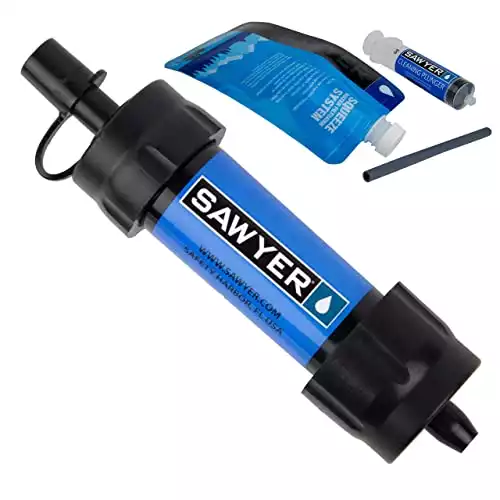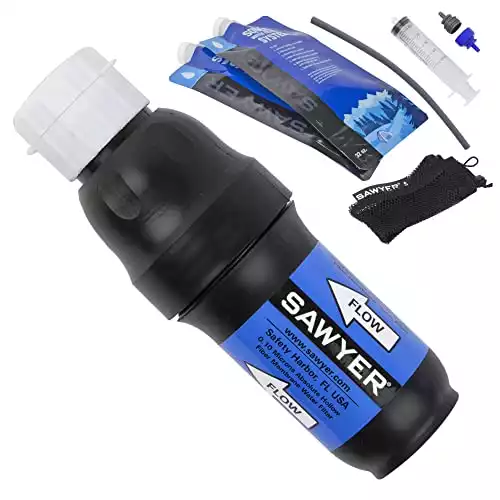The Sawyer Squeeze and Mini are two of the most popular water filtration systems for backpackers. Either would be a great addition to your Bug Out Bag or to keep in your car or at home in case of emergencies.
In this article, we look at the differences between the two to help you decide which is right for you.
Sawyer Squeeze vs Mini – The Winner
There’s not much to choose between them, but the Sawyer Squeeze is better than the Sawyer mini due to its versatility and faster flow rate.
Stats At a Glance
How the Sawyer Squeeze and Mini Work
Both filters use the same hollow fiber membrane. The u-shaped microtubes trap contaminants while letting decontaminated water to pass through the filter.

The membrane can filter out particles down to 0.1 microns, meaning you are safe from nasties such as bacteria (including E. coli, Salmonella typhi, Vibrio cholera and Leptospira), protozoa (including Cryptosporidium and Giardia) and microplastics.
Neither filtration device will filter out viruses. If you’re looking for a water purification system that’s robust enough to treat contaminated water, such as flood water, check out our guide to the best survival water filters.
The filters in the Squeeze and Mini are cleaned in the same way, through backwashing using a syringe supplied with the filter. It’s worth backwashing after every use to keep the flow rate high.
You can also soak it in vinegar occasionally to give it a more thorough clean. See the video below:
If water freezes in the filter, holes may form in the hollow fiber membrane. If you’re using the Squeeze or Mini in cold weather, you’ll need to be extra careful to make sure they don’t freeze up.
How Can You Use Them?
Both filters come with a water pouch (or multiple water pouches, depending on the package you order).
You fill the pouch with dirty water, then either drink directly from the filter or squeeze the pouch, so the water goes through the filter into another container.
If you have a water bladder and hose, you can add the filter into the system by cutting the hose and attaching it to each end of the filter (you’ll need a special adapter for the Squeeze filter). Then fill your bladder with dirty water and suck clean water out through the hose.
You can also use both filters in gravity mode by hanging up the dirty water bag with the filter and a hose attached and letting water drain through into a clean container. (Read more about gravity water filters.)
Flow Rate
While you probably won’t notice much of a difference in flow rate when drinking directly, if you’ve squeezing or using gravity to filter larger volumes of water, the Squeeze has a much better flow rate.
If you’re filtering water for more than one person or you’re refilling all your bottles, the Squeeze will clean your water faster.
You can also buy special adapters for the Squeeze to filter water from your household faucet or a 5-gallon bucket.
This could be useful if you have water quality issues at home (e.g., a cryptosporidium outbreak) or if you’re collecting water from a stream to use at an off-grid Bug Out Location.
Tip: The bags that come with the filters aren’t the most durable. We’d recommend investing in some high-quality soft bottles for longevity.
What’s the Difference?
At first glance, it seems a no-brainer to buy the Mini. It’s smaller, lighter and cheaper than the Squeeze, and both will filter your water to the same standard.
Look a bit more closely, however, and the answer isn’t quite so clear-cut. These are the key differences between the two filtration systems:
- The Mini has a smaller filter than the Squeeze, which means the flow rate is significantly lower. This becomes important when you’re filtering larger volumes of water.
- The Mini is designed to fit directly into a hydration hose.
- The Squeeze is more versatile — it can be connected to a hydration hose, a bucket, or a household faucet — but these all require extra attachments.
- The Mini is cheaper and lighter than the Squeeze.
- The Squeeze is rated to filter 10 times as much water as the Mini. Given the Mini is designed to process 100,000 gallons of water, this is unlikely to be an issue unless you’re thinking very long term. If you need a gallon of water per person per day, the Mini could theoretically keep a family of four supplied with clean water for 68 years.
- The Mini is available in different colors. (In case you want to match your filtration system to your backpack…)
Which Is Best?
This really depends on how you’re going to use it. For backpackers or preppers planning to attach the filter to the hose of a hydration pack, we’d recommend the Sawyer Mini. It’s smaller, lighter, cheaper and doesn’t require a separate adapter to fit into a drinking hose.
However, in terms of versatility and overall performance, the Sawyer Squeeze wins out.
It costs more, particularly if you buy the separate adapters, but will filter large volumes of water more quickly and can be attached to a bucket or household faucet.
The higher flow rate also makes it a better option if you’re filtering water for more than one person.
Looking for another option? Read our comparison review of the Sawyer Mini vs LifeStraw.





My “squeeze” actually threads onto my outside “hose bib” right out of the box….though it is a pain to go outside every morning to refill our water jug in the fridge.
I also was worried about the water concerns from my municipal supply so I also added an RV water pressure regulator so it won’t flow more than 40 gpm through the “squeeze”